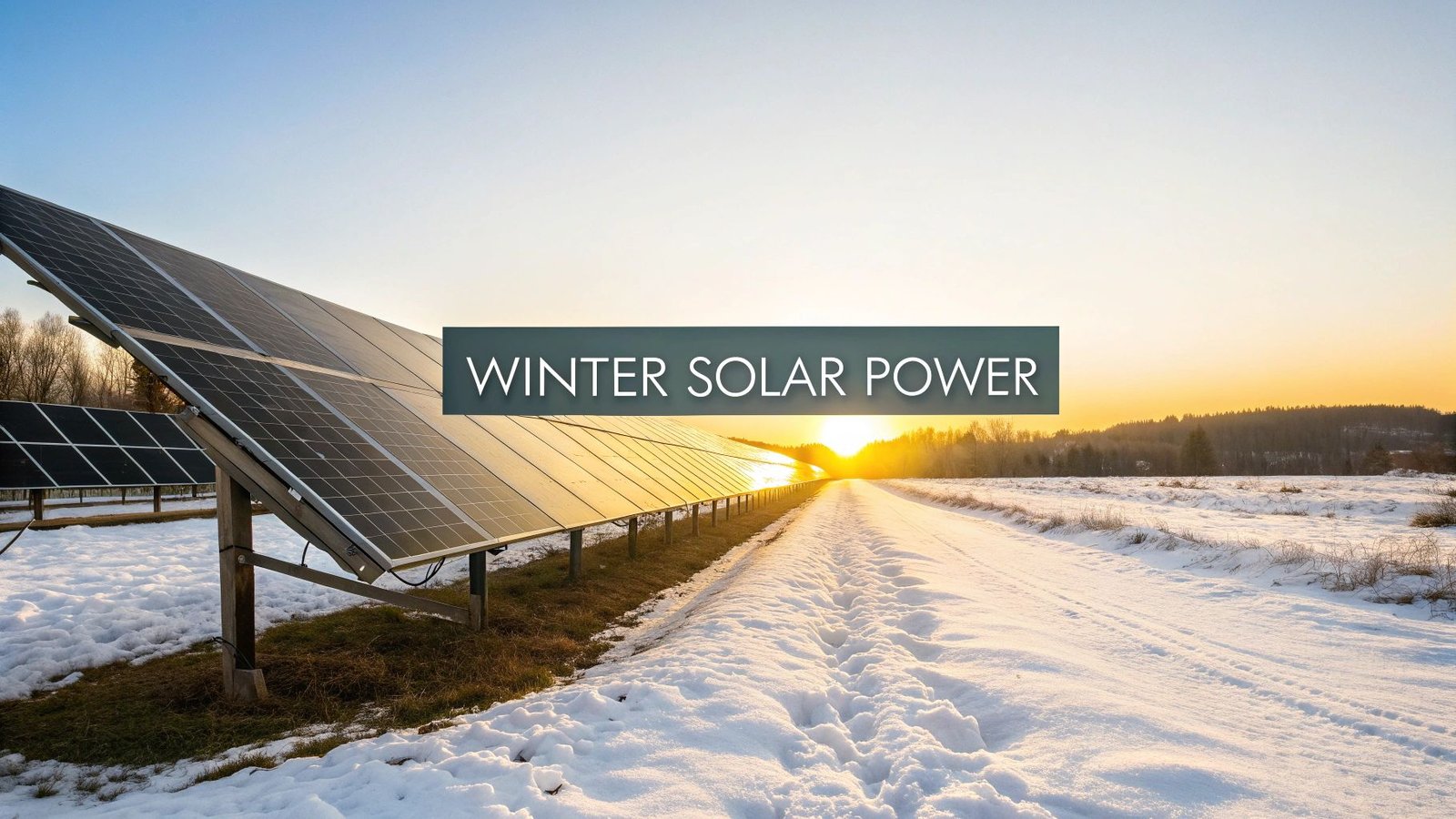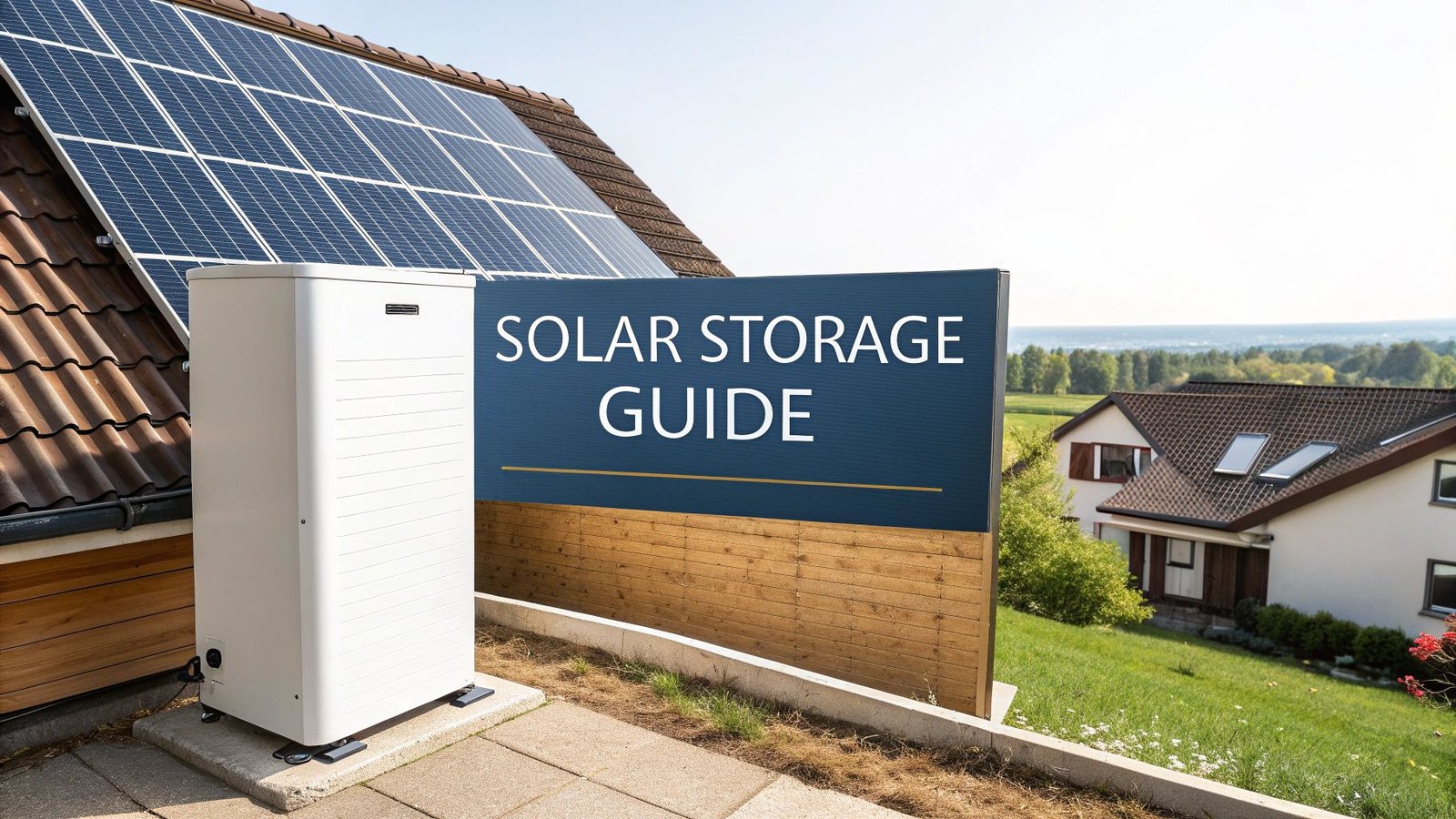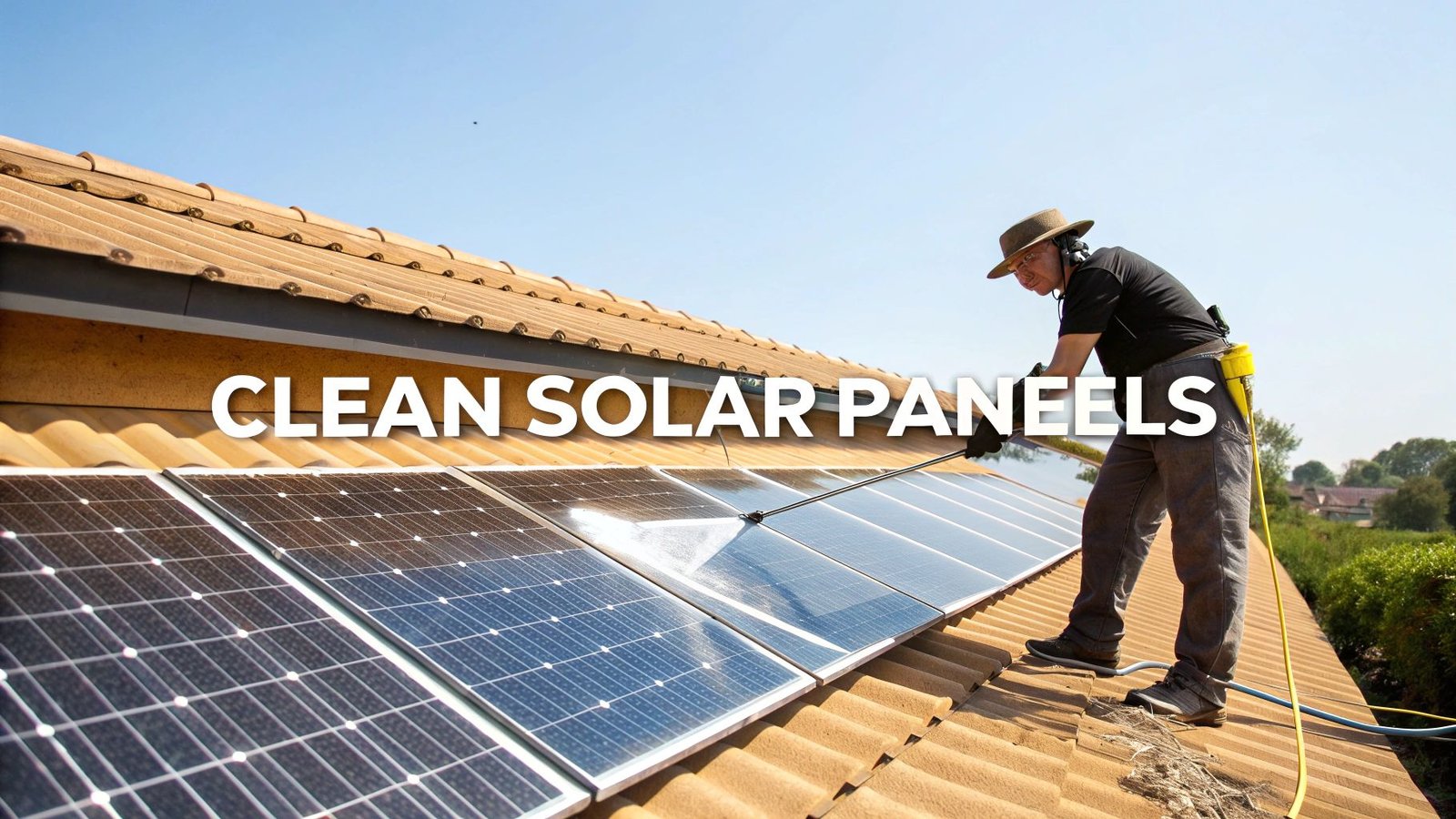It's one of the most common questions we hear: "Do solar panels even work in the winter?"
The short answer is a resounding yes. It’s a persistent myth that solar panels need warmth to generate power. In reality, they run on light, not heat. In fact, the crisp, cold air of winter can actually help them work more efficiently.
While your system's total output will likely be lower than in the summer, your panels are far from dormant during the colder months.
Your Guide to Winter Solar Panel Performance
When homeowners consider going solar, they're often thinking about those long, bright summer days. But what happens when the days get shorter and the temperature drops? It's a crucial question, because understanding how your panels perform year-round is the key to setting the right expectations for energy production and savings.
The truth might surprise you. Solar panels are a lot like other electronics—think of your laptop or smartphone. They actually run better when they're cool. The intense heat of a summer day can increase electrical resistance within the panels, slightly hampering their performance. Winter's chill eliminates that heat, allowing electrons to flow more freely and generate power more efficiently.
The key thing to remember is that solar panels convert sunlight (photons) into electricity, not heat. A bright, cold, and frosty winter day can create near-perfect conditions for your panels to operate at peak efficiency.
Of course, efficiency is only half the story. The other major factor is the total amount of sunlight your panels can capture. Let's break down the main variables that come into play during winter.
Winter Solar Panel Performance at a Glance
This chart illustrates the key factors influencing your solar panels during the colder months, showing how some variables help while others hinder production.
graph TD
A[Winter Solar Production] -->|Negative Impact| B(Shorter Daylight Hours)
A -->|Negative Impact| C(Lower Sun Angle)
A -->|Negative Impact / Situational| D(Snow Cover on Panels)
A -->|Positive Impact| E(Colder Temperatures)
A -->|Positive Impact / Situational| F(Snow on Ground - Albedo Effect)
As you can see, the main reason for lower production in winter isn't the cold—it's the shorter days and the lower angle of the sun in the sky.
Each of these factors plays a role, and we'll dig into them in more detail. For tips on maximizing your system's output no matter the season, check out our guide on optimización de paneles solares.
Why Cold Weather Can Boost Solar Panel Efficiency
Here’s a fact that surprises a lot of people: your solar panels can actually perform better on a bright, frosty morning than on a sweltering summer afternoon. It might sound backward, but it all comes down to a simple principle that applies to almost any electronic device, whether it's your laptop or your phone. They just run more efficiently when they're cool.
Solar panels are the same way. While they obviously need sunlight to generate electricity, excessive heat is actually their enemy. Think of the heat as creating a massive traffic jam on an electrical highway. As the panel gets hotter, the electrical resistance inside its photovoltaic (PV) cells increases. This resistance makes it harder for electrons to flow freely, which in turn, reduces the amount of power the panel can produce.
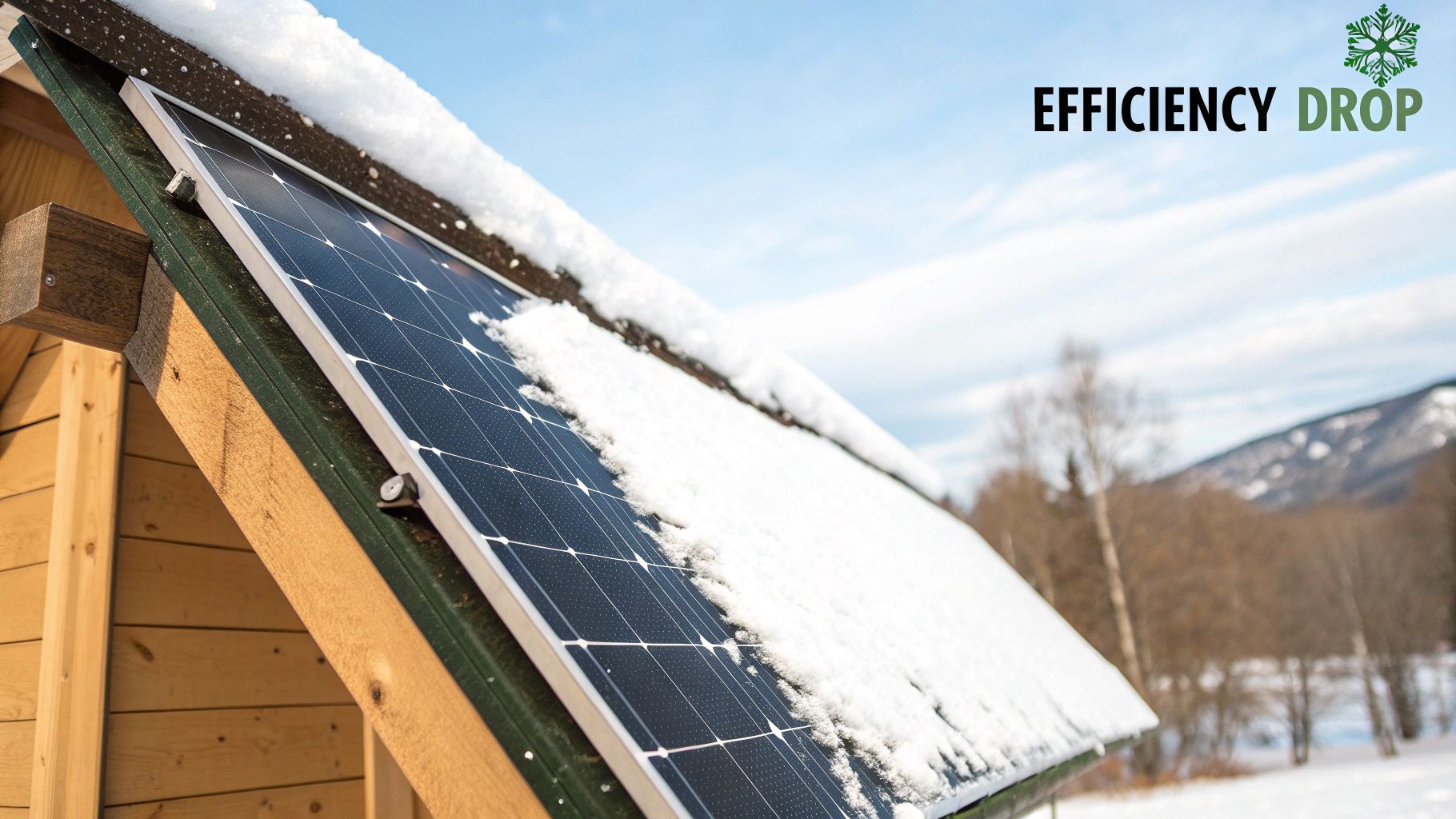
The Science Behind Cold Weather Efficiency
When winter rolls in, that cold, crisp air acts like a natural cooling system for your panels. It constantly pulls excess heat away, clearing up that electrical "traffic jam" we just talked about. With less resistance, electrons can zip through the solar cells much more easily once they're energized by sunlight.
This is precisely why solar panels work in winter with such impressive efficiency. The crucial thing to remember is that panels convert light (photons) into electricity, not heat. On a clear, cold day, you get plenty of sunlight without the heat that drags down performance. If you want to dive deeper into the hardware that makes this happen, check out this fantastic guide to the components of a solar panel.
In fact, a solar panel's power output can increase as the temperature drops below the standard test conditions of 25°C (77°F). This means a bright, freezing day can create the perfect environment for your panels to operate at their absolute peak.
Visualizing the Temperature and Efficiency Link
This inverse relationship between heat and efficiency is a key part of understanding year-round solar production. While a blistering hot day in July might feel like prime time for solar energy, each panel's efficiency is actually a bit lower because of the heat. On the flip side, a sunny February day lets your system convert sunlight into power at a much higher rate.
The chart below shows this perfectly. As a solar panel's temperature climbs, its maximum power output steadily drops. This is the hidden advantage solar homeowners have on those cold, clear days.
Temperature Impact on Solar Panel Output
xychart-beta
title "Solar Panel Efficiency vs. Temperature"
x-axis "Panel Temperature (°F)" [10, 45, 77, 100, 120]
y-axis "Relative Power Output (%)" [85, 110]
line [105, 102, 100, 94, 89]
bar [105, 102, 100, 94, 89]
Of course, the total amount of power you generate in winter is lower because of shorter days—a factor we'll get into next. But when you look at pure, raw efficiency, cold weather gives your solar panels an unexpected edge.
How Shorter Days and a Lower Sun Limit Winter Output
While the cold weather actually gives solar panels a nice little efficiency boost, the real MVP for winter energy production is simply sunlight. Or, more accurately, the lack of it. The two biggest hurdles your solar system has to clear in the winter are shorter days and a sun that sits much lower in the sky.
Think of your solar array like a factory. In the summer, that factory is running a long, busy shift under bright, direct overhead lights. But come winter, the shifts get cut short, and the lighting is dimmer and off to the side. The factory is still running, but it’s just not going to be as productive.
This combination of less daylight and weaker sunlight has a direct impact on your system's "peak sun hours." That's the term we use for the time when the sun is intense enough for panels to crank out energy at or near their maximum rating. A long summer day might give you six or seven peak sun hours, but a short winter day could be as low as two or three.
The Double-Whammy of the Winter Sun
Fewer daylight hours is pretty straightforward—less time for the sun to be out means less time to make power. Simple enough. But the sun’s lower position in the winter sky has a sneaky, and just as significant, effect on your output.
When the sun is low on the horizon, its rays have to travel through more of the Earth's atmosphere to get to your roof. This extra travel distance weakens the sunlight, almost like a filter. It's the difference between looking through a crystal-clear window and a foggy one; less of the good stuff gets through.
This image really drives home how much those reduced daylight hours impact your system’s overall output.
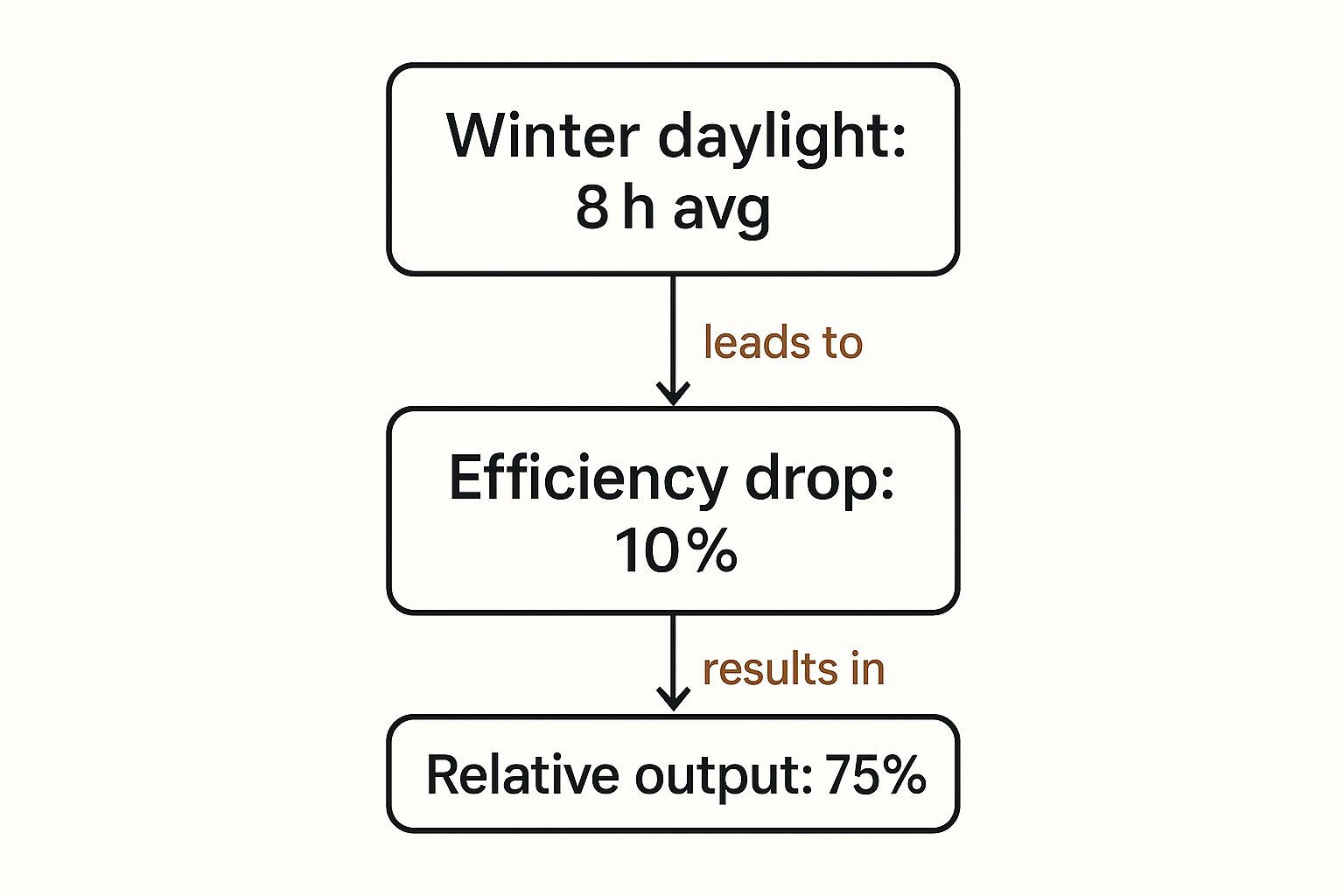
As you can see, even if your panels are working at peak efficiency, the sheer drop in available sunlight is the main reason you'll see lower energy generation numbers in the winter.
Putting It All into Perspective
This is just the reality of solar energy everywhere, from a small residential setup to a massive solar farm. Engineers and designers plan for this seasonal dip. For instance, a 220-kW system might be designed to produce 300,000 kWh over a whole year, with everyone fully expecting its monthly numbers to drop when winter rolls around. You can find more great info on solar panel seasonality on environbuzz.com.
The key takeaway is this: your solar panels are still working hard and efficiently in the cold, but they simply have less fuel—sunlight—to work with. This is a normal, expected part of a solar energy system's annual production cycle.
Knowing this helps you set realistic expectations for your monthly energy bills. You can plan for your system to be an absolute powerhouse during the long, bright days of summer, banking credits and energy to help offset the lower production of the shorter winter months. It’s all part of the annual balancing act that makes solar such a great investment year-round.
Understanding How Snow Impacts Your Solar Panels
When winter rolls in, a lot of homeowners worry that snow is the ultimate kryptonite for solar panels. It’s a fair concern—a thick blanket of fresh powder can definitely stop your system in its tracks, at least for a little while. But the story of snow and solar isn't quite so simple.
The good news is that your panels have a few tricks up their sleeve. Most are installed at an angle, and their dark surface soaks up whatever sunlight it can get. This combination creates just enough warmth to help snow melt and slide right off, especially on a sunny day. You might be surprised how quickly they clear themselves, even after a heavy storm.
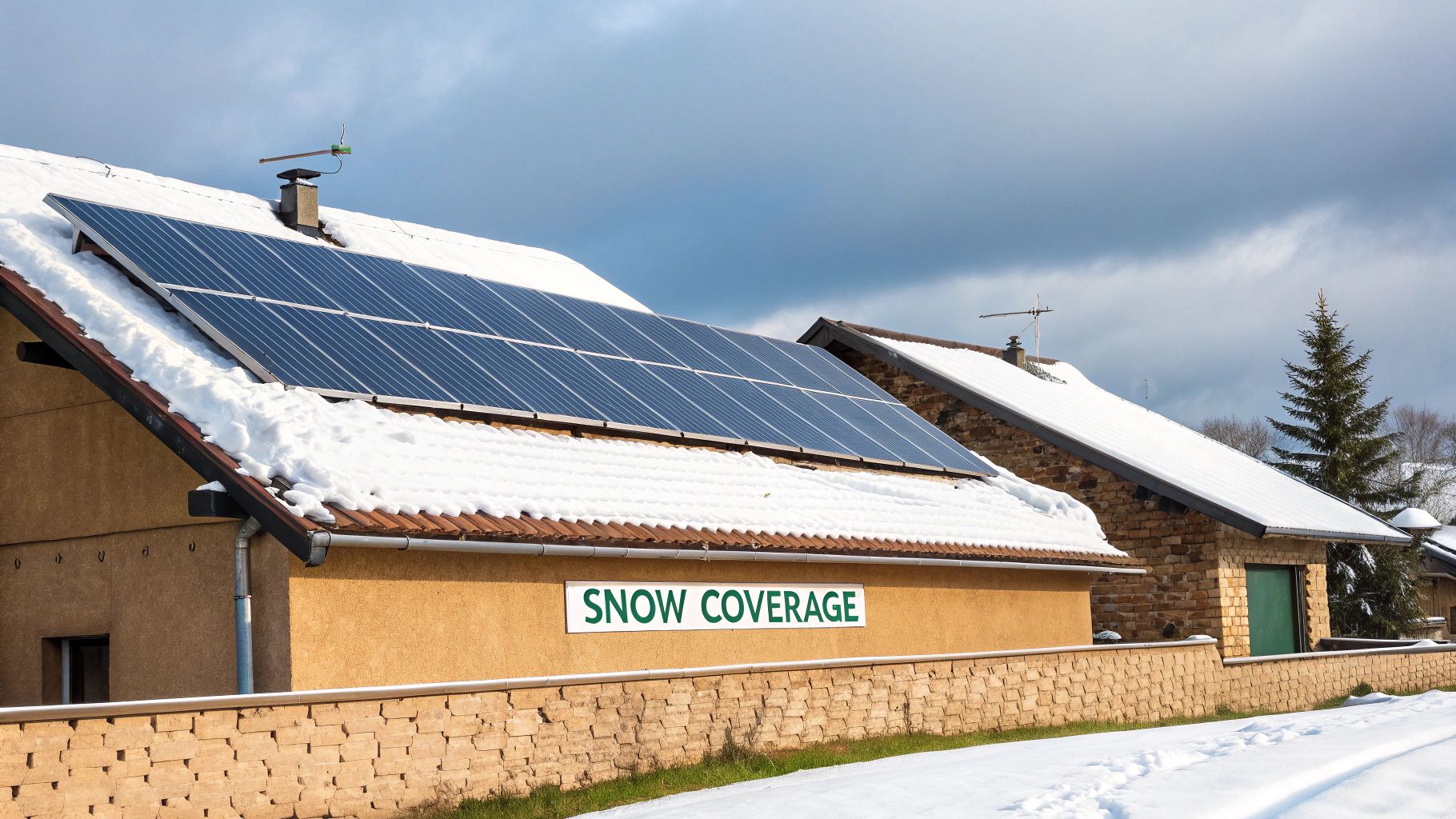
The Surprising Boost from the Albedo Effect
While snow on your panels is a problem, snow on the ground can be a huge help. It all comes down to a cool phenomenon called the albedo effect—which is just a fancy way of talking about how well a surface reflects light.
Fresh snow is one of the most reflective surfaces on the planet. Think of it as a giant, natural mirror laid out across your yard. On a clear day after a snowfall, this mirror bounces sunlight back up from the ground, giving your panels a second dose of solar energy they wouldn't normally get. So, even as you wait for the snow to clear off your roof, the snow on the ground might already be boosting your system’s output.
Putting Snow's Impact into Perspective
Even with a few snow days here and there, solar panels still pull their weight all winter long. Research from famously gray and snowy places backs this up. For instance, one study in Portland, Oregon, found that solar panels still operate at about 65% of their summer efficiency during the winter. That’s pretty impressive considering the clouds and shorter days.
This is because modern panels are great at capturing diffuse sunlight, meaning solar panels work in winter even when it's overcast. To learn more about this, check out some great insights on winter solar performance on sunrun.com.
The bottom line? Snow might cause a temporary dip in production, but it rarely shuts down your system for long. Between the panels' self-clearing ability and the helpful albedo effect, snow is just a manageable part of the winter solar journey.
So, snow can be both a friend and a foe to your solar setup. Here's a quick breakdown of how it plays out.
Snow and Solar Panels: The Good and The Bad
pie
title Snow's Dual Impact on Solar Production
"Snow on Panels (Negative)" : 55
"Snow on Ground (Positive)" : 45
This chart visualizes the contrasting effects of snow. While accumulation directly on panels halts production, snow-covered ground can reflect light and provide a surprising boost.
Actionable Tips for Maximizing Winter Solar Production
Knowing that your panels can still produce power in the winter is great, but you can do a few things to help them perform at their absolute best. With a handful of simple strategies, you can make sure your system is soaking up every possible ray of sunlight, even on the shortest days of the year.
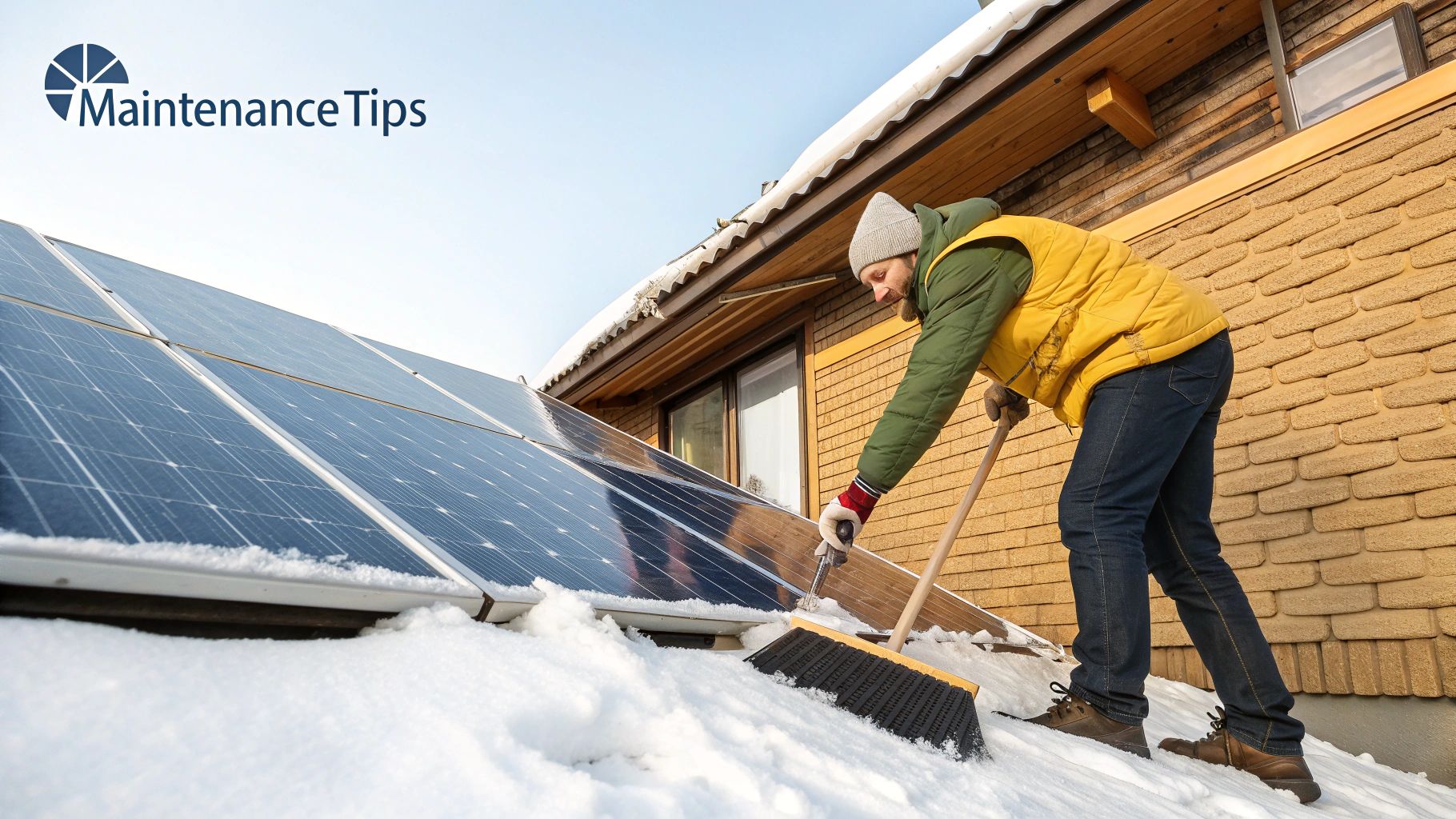
The first step actually happens long before the first snowflake falls—it's all about the installation. Getting the angle of your panels right is crucial for winter performance. A steeper pitch does two things: it better catches the low-hanging winter sun, and it lets gravity do the work of helping snow slide right off.
Safe and Effective Snow Removal
Most of the time, the sun and the panel's angle are enough to clear light snow on their own. But sometimes, heavy, wet snow can stick around and block production. If you decide to clear them yourself, remember that safety is everything. The best approach is using a long-handled snow rake with a soft head, allowing you to clear the panels safely from the ground.
Never, ever climb onto a snowy or icy roof to clear your panels. The risk of a fall is incredibly high, and no amount of extra energy production is worth a serious injury.
Using the right tools is also non-negotiable. Being too aggressive can easily damage your investment.
Snow Removal Dos and Don'ts:
- DO use a soft snow rake made specifically for solar panels.
- DON'T use metal rakes, stiff brooms, or anything sharp that could scratch the glass surface.
- DO wait for a sunny day if you can. The sun will start melting the snow, making it much easier and safer to remove.
- DON'T pour hot water on the panels. The sudden temperature shock can create microcracks in the glass, compromising their integrity.
Winter Maintenance and Energy Storage
After the snow melts away, it often leaves a film of dirt and grime that can cut down on your system’s efficiency. A quick rinse with a garden hose on a mild winter day can make a surprisingly big difference in how much power you generate.
For true winter energy independence, pairing your solar array with a home battery system is a total game-changer. A battery lets you store any excess power your panels generate on a bright, sunny afternoon. You can then tap into that stored energy during a string of cloudy days or overnight, making sure you get the most value out of every kilowatt.
Having the right equipment from the start makes all the difference, which is why it's so important to understand cómo elegir paneles solares and other components that are well-suited for your specific climate.
Your Winter Solar Questions Answered
Even after getting the basics down, you probably still have a few specific questions swirling around. That’s perfectly normal. Let's tackle some of the most common worries homeowners have about their solar panels during the winter months.
Will My Solar Panels Be Damaged By Heavy Snow Or Ice?
It’s a fair question, especially if you live somewhere that gets hammered by winter storms. The good news is, high-quality solar panels are built like tanks. They go through some serious testing to make sure they can handle harsh weather, from the weight of a heavy snowpack to the impact of hail.
The frames are typically made from tough anodized aluminum, with a surface of tempered glass that’s designed to take a beating. Most panels are certified to handle surprisingly heavy snow loads, often far more than you'd ever see on your roof.
While a truly extreme weather event could theoretically cause damage, it's incredibly rare. For the vast majority of homeowners, the structural integrity of the panels just isn't something to lose sleep over. Plus, that natural tilt of the panels on your roof helps snow slide right off before it gets heavy enough to be an issue.
How Much Will My Electricity Bill Savings Drop In The Winter?
Okay, let's be realistic: your savings will almost certainly be lower in the winter than in the peak of summer. But this is exactly what your solar system is designed for. The whole financial model, especially if you have net metering, is based on annual production, not month-to-month.
Think of it like this: your panels work overtime during the long, sunny days of summer, banking extra energy credits with the utility company. Then, when the shorter, cloudier days of winter roll around and production dips, you "cash in" those credits to offset your bills.
The exact drop varies depending on where you live and the specifics of your system, but it all balances out. In fact, a five-year study from the Northern Alberta Institute of Technology (NAIT) found that the total annual energy loss from snow coverage was a mere 3%. It's often a much smaller factor than people assume.
The annual production cycle is key. Your system works overtime in the summer to build up a surplus, which acts as a financial cushion during the shorter, less sunny days of winter.
Do I Need To Turn My Solar Panels Off During A Winter Storm?
Nope, you can leave them be! Solar panel systems are designed to be completely hands-off and operate automatically in all kinds of weather.
They have safety mechanisms built right in. If the power grid goes down during a storm, your system will automatically shut off as a safety measure. This is critical because it prevents electricity from flowing back into the grid, which could endanger utility workers trying to make repairs.
Unless you've specifically invested in a battery backup system for off-grid power, your panels will power down when the grid does. There's nothing you need to do manually.
Is It Worth Getting Solar If I Live In A Very Cloudy Or Snowy City?
Absolutely. You might be surprised to learn that some of the biggest solar adopters in the world, like Germany, aren't exactly known for their sunny beaches. This is great proof that solar panels work in winter and are highly effective even in colder, cloudier climates.
Panels don't need blazing, direct sun to work their magic. They can still generate a good amount of power from the diffuse, indirect sunlight that filters through the clouds. Sure, a cloudy day won't match the output of a bright, clear one, but production definitely doesn't grind to a halt.
And as we talked about earlier, panels are actually more efficient in the cold, which helps make up for some of the lost output from cloud cover. The chart below gives a rough idea of how production changes with the seasons—it dips, but it never drops to zero.
Estimated Monthly Solar Production by Season (Example System)
gantt
title Seasonal Solar Energy Production
dateFormat YYYY-MM-DD
axisFormat %B
section Summer (High Production)
Peak Output :crit, 2024-06-01, 90d
section Autumn (Decreasing Production)
Moderate Output : 2024-09-01, 90d
section Winter (Lowest Production)
Low Output :active, 2024-12-01, 90d
section Spring (Increasing Production)
Moderate Output : 2025-03-01, 90d
Ultimately, whether solar makes sense for you comes down to your local electricity costs and available incentives, not just your geography. With today's high-efficiency panels, solar is a smart investment for many people in snowy, overcast regions.
Ready to see how solar can work for your home, no matter the season? The team at Energía radiante specializes in designing and installing high-performance solar solutions tailored to your specific climate and energy needs. Contact us today for a free consultation and discover your path to energy independence.

